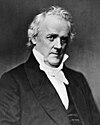1858 United States elections
 From Wikipedia the free encyclopedia
From Wikipedia the free encyclopedia
| ← 1856 1857 1858 1859 1860 → Midterm elections | |
| Incumbent president | James Buchanan (Democratic) |
|---|---|
| Next Congress | 36th |
| Senate elections | |
| Overall control | Democratic hold |
| Seats contested | 22 of 66 seats[1] |
| Net seat change | Republican +5[2] |
| House elections | |
| Overall control | Republican gain |
| Seats contested | All 238 voting seats |
| Net seat change | Republican +23[2] |
 | |
| 1858 House of Representatives election net gains by state 6+ Republican gain 3 to 5 Republican gain 1 to 2 Republican gain 1 to 2 Democratic gain Territory | |
The 1858 United States elections occurred in the middle of Democratic President James Buchanan's term and marked the end of the transitional period between the Second Party System and the Third Party System.[3] Members of the 36th United States Congress were chosen in this election. In the first election since the Supreme Court decided Dred Scott v. Sandford, the Republican Party won a plurality in the House, taking control of a chamber of Congress for the first time in the party's history. Although Democrats lost control of the House, they retained their majority in the Senate.
In the House, Democrats suffered a major defeat, losing seats to Republicans and a group of southern party members who opposed secession, running on the Opposition Party ticket. Although no party won a majority, Republicans won a plurality of seats.[4] Republican William Pennington won election as Speaker of the House, becoming the first Republican Speaker.
In the Senate, Republicans picked up several seats, but Democrats retained a commanding majority.[5]
See also[edit]
References[edit]
- ^ Not counting special elections.
- ^ a b Congressional seat gain figures only reflect the results of the regularly-scheduled elections, and do not take special elections into account.
- ^ "Economic Change and Political Realignment in Antebellum Pennsylvania". The Pennsylvania Magazine of History and Biography. 113 (3). The Pennsylvania Magazine of History and Biography, vol. 113, no. 3, 1989, pp. 347–95. JSTOR: 347–395. 1989. JSTOR 20092358. Retrieved 14 September 2022.
- ^ "Party Divisions of the House of Representatives". United States House of Representatives. Retrieved 25 June 2014.
- ^ "Party Division in the Senate, 1789-Present". United States Senate. Retrieved 25 June 2014.
